overheating CHEVROLET CAVALIER 1996 3.G Owners Manual
[x] Cancel search | Manufacturer: CHEVROLET, Model Year: 1996, Model line: CAVALIER, Model: CHEVROLET CAVALIER 1996 3.GPages: 372, PDF Size: 19.73 MB
Page 128 of 372
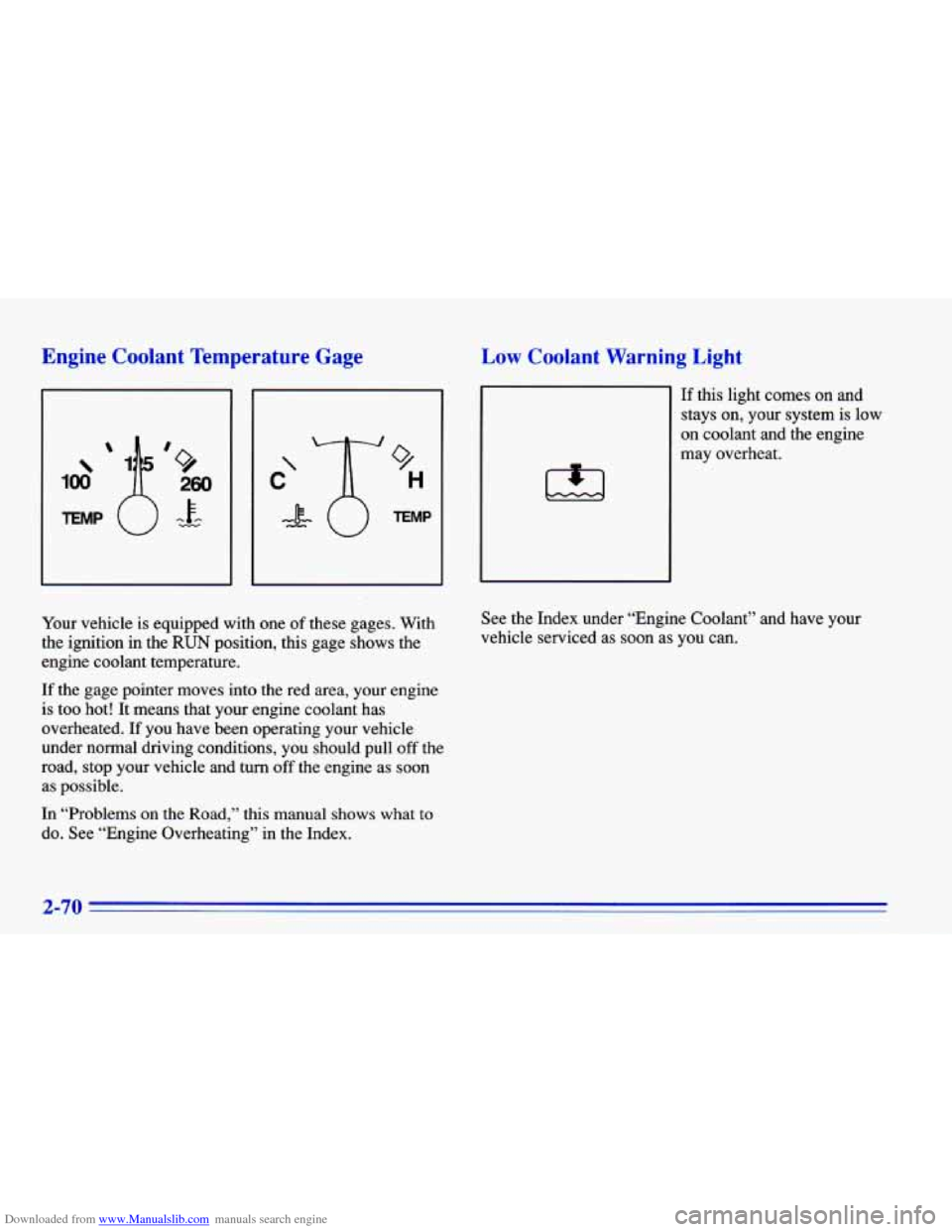
Downloaded from www.Manualslib.com manuals search engine Engine Coolant Temperature Gage
100
9
H
TEMP
Low Coolant Warning Light
1,1
If this light comes on and
stays on, your system is low
on coolant and the engine
may overheat.
Your vehicle
is equipped with one of these gages. With
the ignition in the
RUN position, this gage shows the
engine coolant temperature.
If the gage pointer moves into the red area, your engine
is too hot! It means that your engine coolant has
overheated.
If you have been operating your vehicle
under normal driving conditions,
you should pull off the
road, stop your vehicle and turn
off the engine as soon
as possible.
In “Problems on the Road,” this manual shows what
to
do. See “Engine Overheating” in the Index. See
the Index under “Engine Coolant” and have your
vehicle serviced
as soon as you can.
2-70
Page 201 of 372
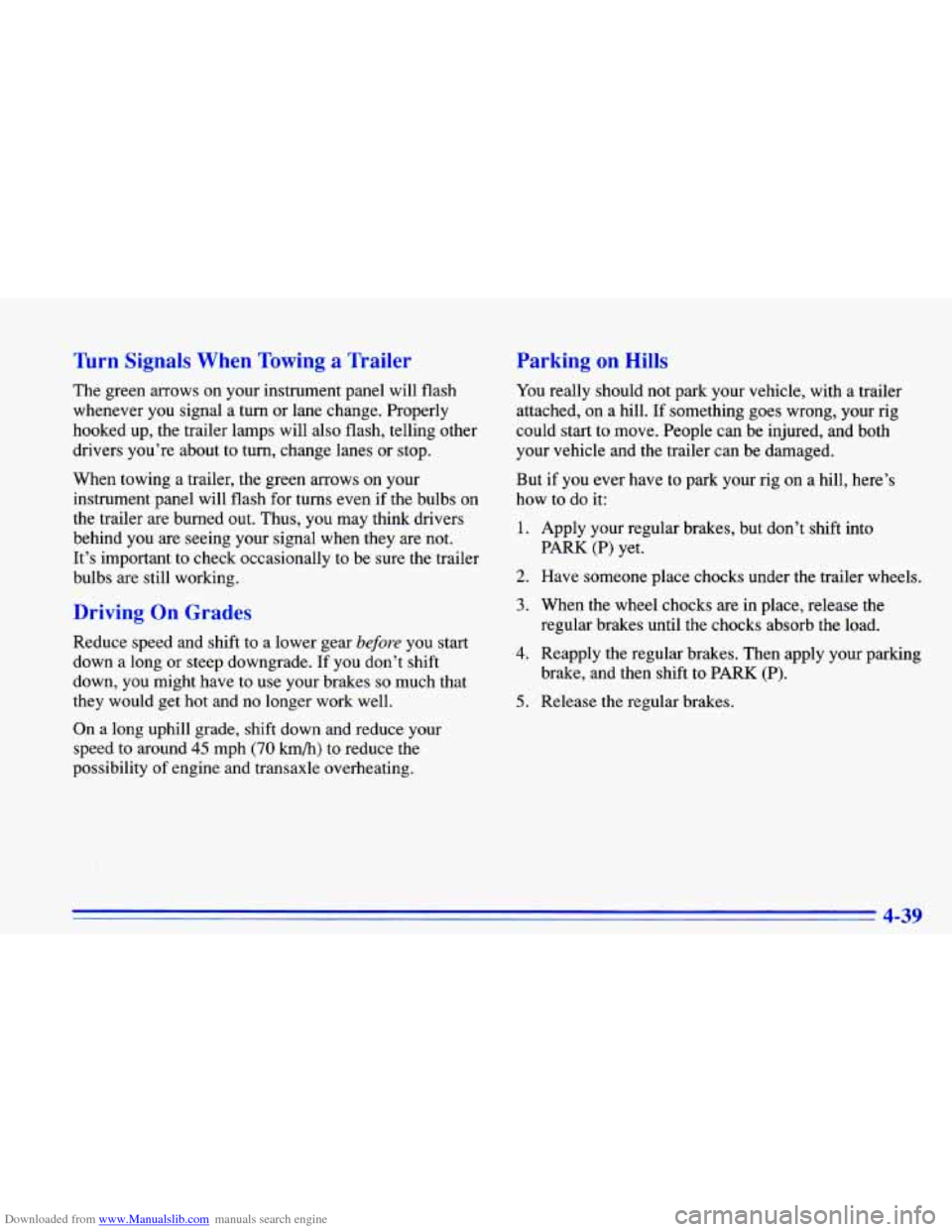
Downloaded from www.Manualslib.com manuals search engine firn Signals When Towing a Trailer
The green arrows on your instrument panel will flash
whenever you signal a turn or lane change. Properly
hooked up, the trailer lamps will also flash, telling other
drivers you’re about to turn, change lanes or stop.
When towing a trailer, the green arrows on your
instrument panel will flash for turns even if the bulbs on
the trailer are burned out. Thus, you may think drivers
behind you are seeing your signal when they are not.
It’s important to check occasionally to be sure the trailer
bulbs are still working.
Driving On Grades
Reduce speed and shift to a lower gear before you start
down
a long or steep downgrade. If you don’t shift
down, you might have to use your brakes
so much that
they would get hot and no longer work well.
On a long uphill grade, shift down and reduce your
speed to around
45 mph (70 km/h) to reduce the
possibility of engine and transaxle overheating.
Parking on Hills
You really should not park your vehicle, with a trailer
attached, on a hill. If something goes wrong, your
rig
could start to move. People can be injured, and both
your vehicle and the trailer can be damaged.
But if you ever have to park your rig on a hill, here’s
how to do
it:
1. Apply your regular brakes, but don’t shift into
2. Have someone place chocks under the trailer wheels. PARK
(P) yet.
3. When the wheel
chocks are in place, release the
regular brakes until the chocks absorb the load.
4. Reapply the regular brakes. Then apply your parking
brake, and then shift to PARK
(P).
5. Release the regular brakes.
4-39
Page 217 of 372
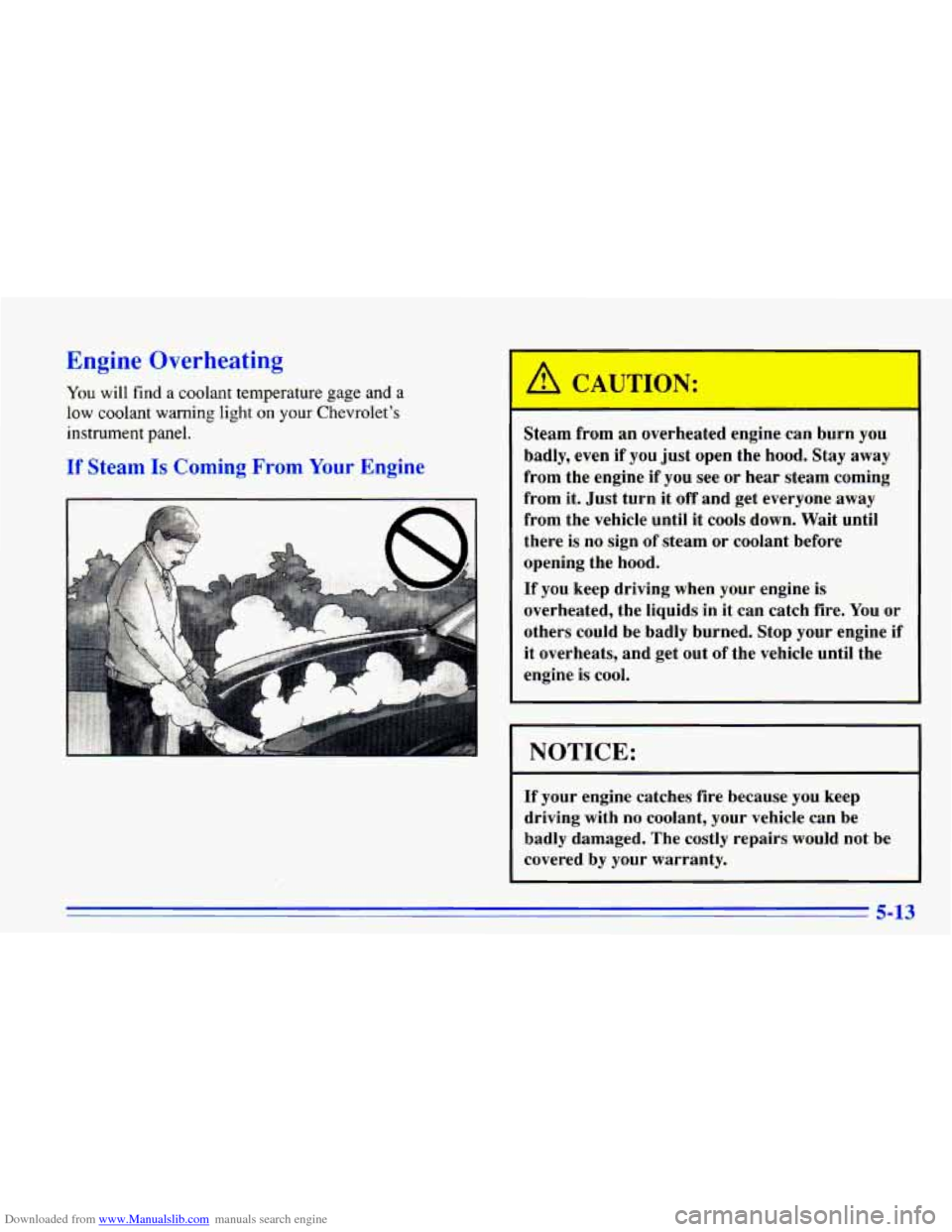
Downloaded from www.Manualslib.com manuals search engine Engine Overheating
You will find a coolant temperature gage and a
low coolant warning light on your Chevrolet’s
instrument panel. Steam
from an overheated engine can burn you
badly, even if you just open the hood. Stay away
from the engine if you
see or hear steam coming
from it. Just turn it
off and get everyone away
from the vehicle until it cools down. Wait until
there is no sign of steam or coolant before
opening the hood.
If you keep driving when your engine
is
overheated, the liquids in it can catch fire. You or
others could be badly burned. Stop your engine
if
it overheats, and get out of the vehicle until the
engine is cool.
I NOTICE:
If your engine catches fire because you keep
driving with no coolant, your vehicle can be
badly damaged. The costly repairs would not be
covered by your warranty.
5-13
Page 220 of 372
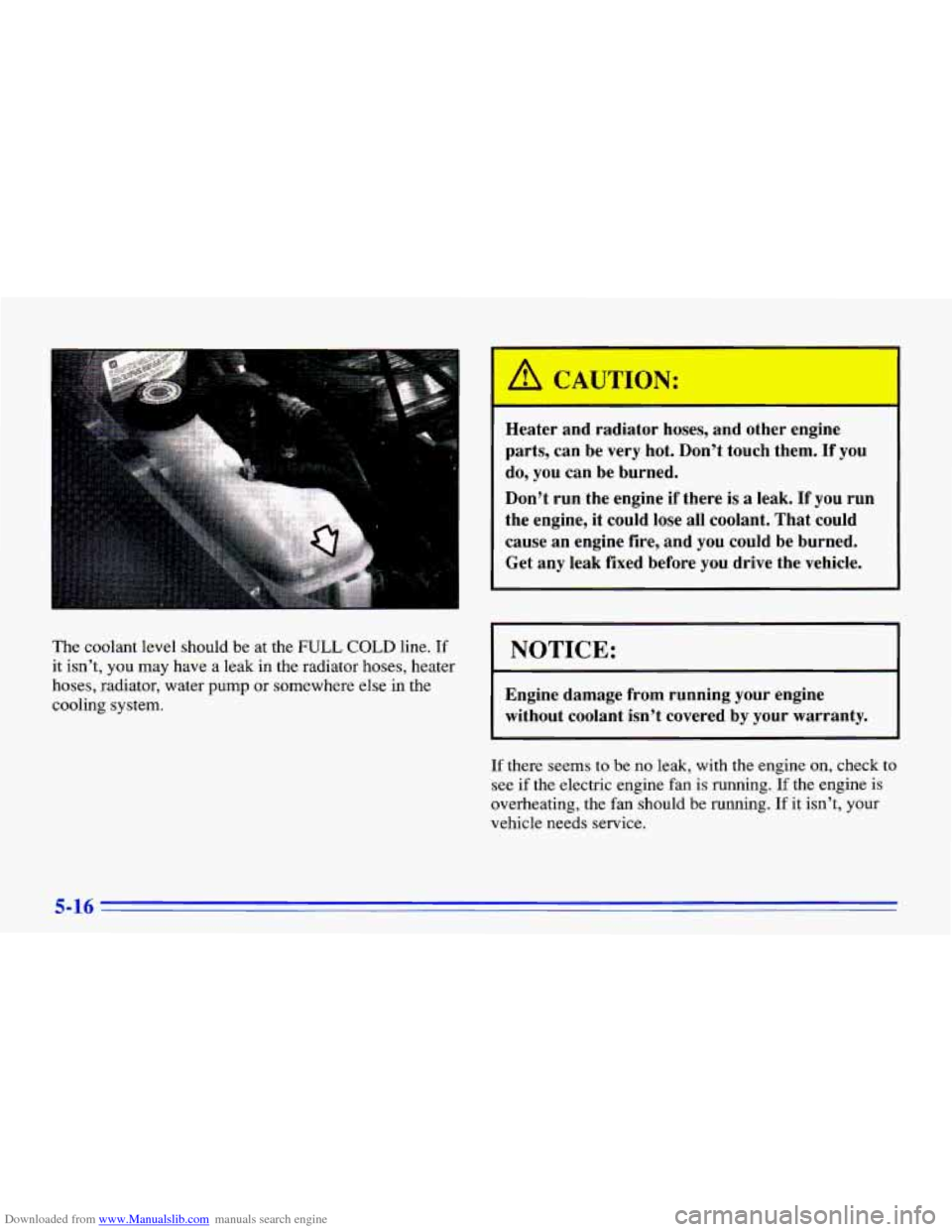
Downloaded from www.Manualslib.com manuals search engine The coolant level should be at the FULL COLD line. If
it isn’t, you may have a leak in the radiator hoses, heater
hoses, radiator, water pump
or somewhere else in the
cooling system.
’ A C * UTION:
-- I
Heater and radiator hoses, and other engine
parts, can be very hot. Don’t touch them. If you
do, you can be burned.
Don’t run the engine
if there is a leak. If you run
the engine, it could lose all coolant. That could
cause an engine fire, and you could be burned.
Get any leak fixed before you drive the vehicle.
I NOTICE:
r
~~ ~
Engine damage from running your engine
without coolant isn’t covered by your warranty.
If there seems to be no leak, with the engine on, check to
see if the electric engine fan is running.
If the engine is
overheating, the fan should be running. If it isn’t, your
vehicle needs service.
Page 260 of 372
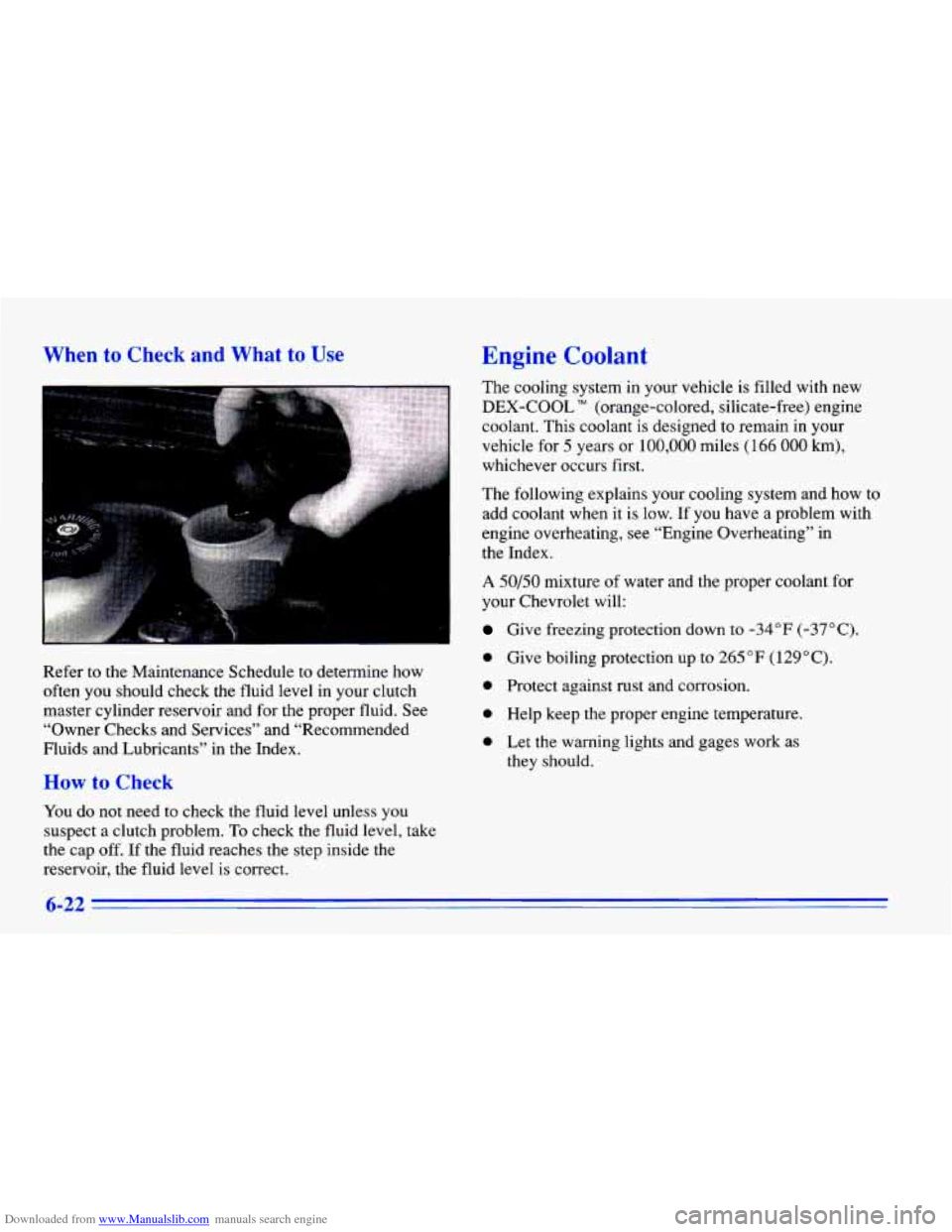
Downloaded from www.Manualslib.com manuals search engine When to Check and What to Use
Refer to the Maintenance Schedule to determine how
often you should check the fluid level in your clutch
master cylinder reservoir and for the proper fluid. See
“Owner Checks and Services” and “Recommended
Fluids and Lubricants” in the Index.
How to Check
You do not need to check the fluid level unless you
suspect a clutch problem. To check the fluid level, take
the cap off.
If the fluid reaches the step inside the
reservoir, the fluid level
is correct.
Engine Coolant
The cooling system in your vehicle is filled with new
DEX-COOL TM (orange-colored, silicate-free) engine
coolant. This coolant is designed to remain in your
vehicle for
5 years or 100,000 miles ( 166 000 km),
whichever occurs first.
The following explains your cooling system and how to
add coolant when it is low. If you have a problem with
engine overheating, see “Engine Overheating” in
the Index.
A 50/50 mixture of water and the proper coolant for
your Chevrolet will:
Give freezing protection down to -34°F (-37OC).
e Give boiling protection up to 265 “F (129°C).
0 Protect against rust and corrosion.
e Help keep the proper engine temperature.
e Let the warning lights and gages work as
they should.
6-22
Page 263 of 372
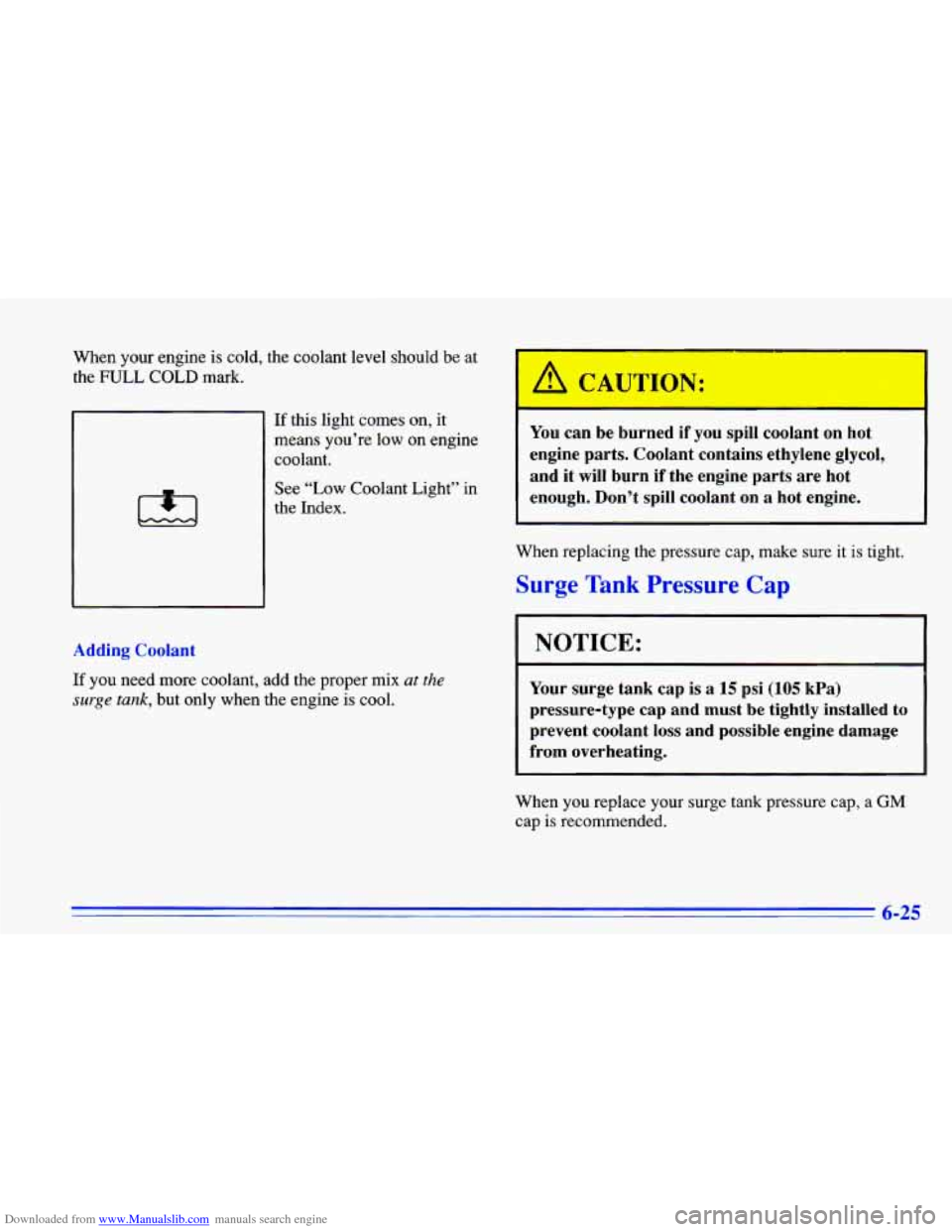
Downloaded from www.Manualslib.com manuals search engine When your engine is cold, the coolant level should be at
the
FULL COLD mark.
If this light comes on, it
means you’re low on engine
coolant.
See “Low Coolant Light” in
the Index.
Adding Coolant
If you need more coolant, add the proper mix at the
surge tank, but only when the engine is cool.
‘ A CAUTION:
You can be burned if you spill coolant on hot
engine parts. Coolant contains ethylene glycol,
and it will burn
if the engine pasts are hot
enough. Don’t spill coolant on
a hot engine.
When replacing the pressure cap, make sure it is tight.
Surge Tank Pressure Cap
Your surge tank cap is a 15 psi (105 kPa)
pressure-type cap and must be tightly installed
to
prevent coolant loss and possible engine damage
from overheating.
When you replace your surge tank pressure cap, a GM
cap is recommended.
6-25
Page 274 of 372
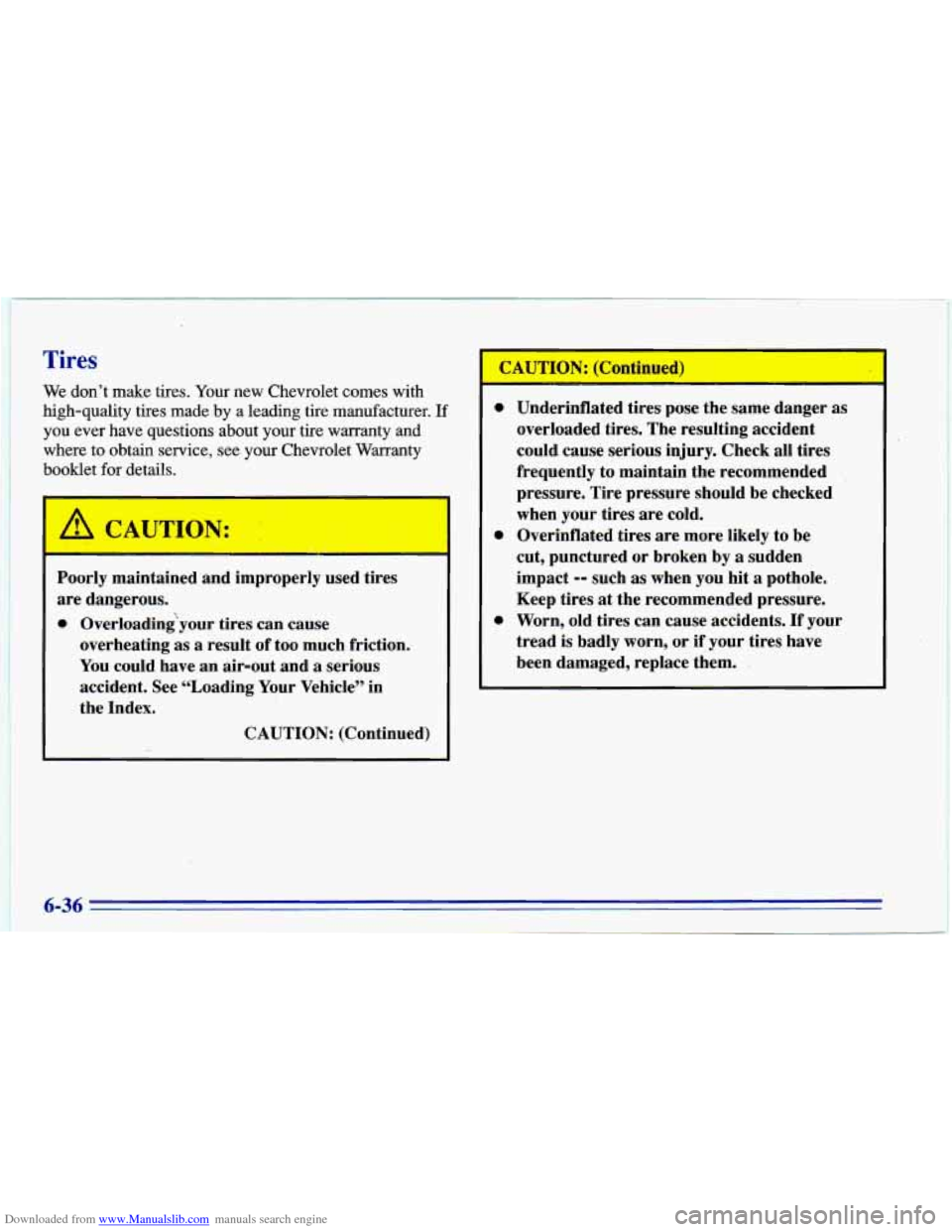
Downloaded from www.Manualslib.com manuals search engine Tires
We don’t make tires. Your new Chevrolet comes with
high-quality tires made
by a leading tire manufacturer. If
you ever have questions about your tire warranty and
where to obtain service, see your Chevrolet Warranty
booklet for details.
Poorly maintained and improperly used tires
are dangerous.
0 Overloadingyour tires can cause
overheating as
a result of too much friction.
You could have an air-out and
a serious
accident, See “Loading Your Vehicle” in
the Index.
CAUTION: (Continued)
-
L
0 Underinflated tires pose the same danger as
overloaded tires. The resulting accident
could. cause serious injury. Check all tires
frequently to maintain the recommended
pressure. Tire pressure should be checked
when your tires are cold.
cut, punctured or broken by
a sudden
impact
-- such as when you hit a pothole.
Keep tires at the recommended pressure.
0 Worn, old tires can cause accidents. If your
tread is badly worn, or if your tires have
been damaged, replace them.
0 Overinflated tires are more likely to be
6-36
Page 362 of 372
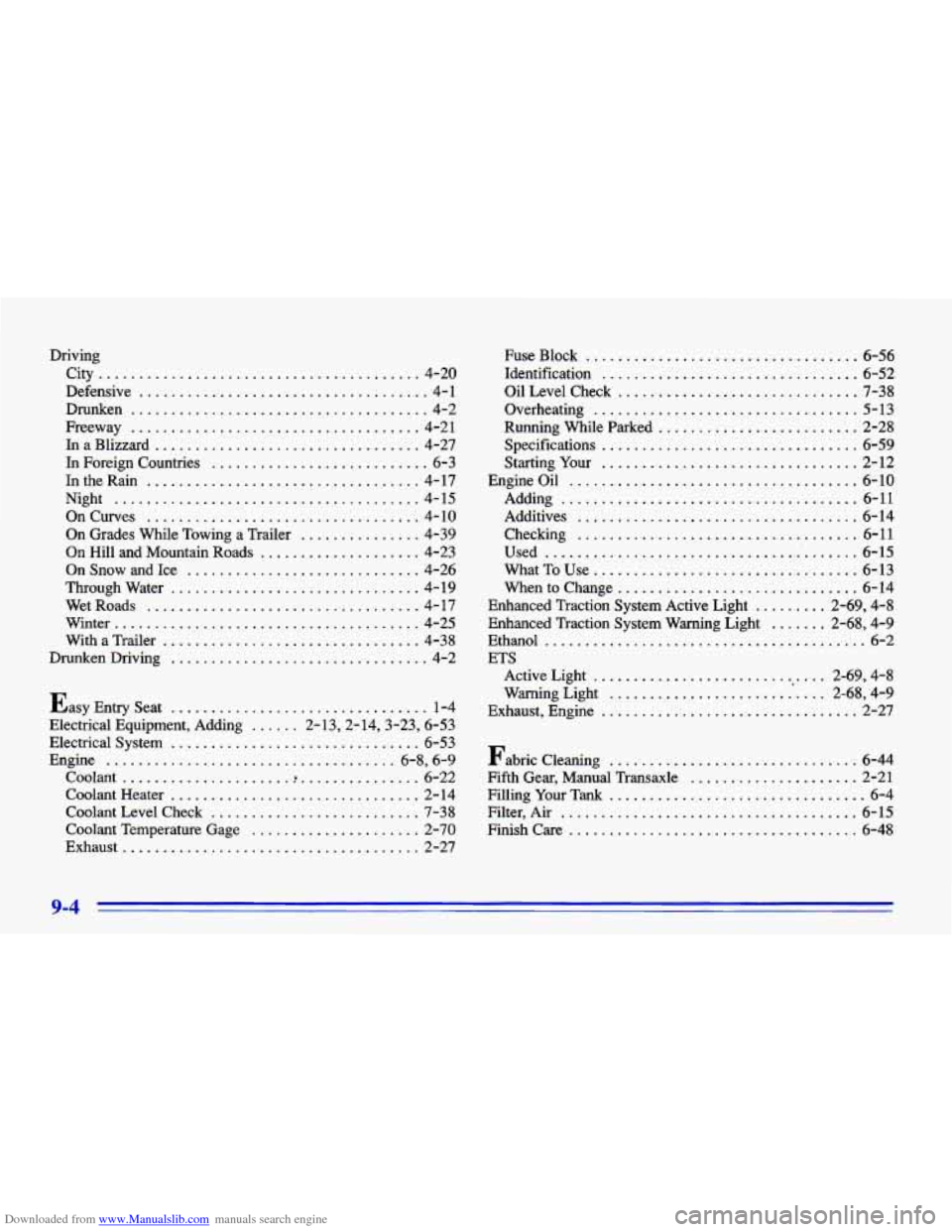
Downloaded from www.Manualslib.com manuals search engine Driving City
........................................ 4-20
Defensive
.................................... 4- 1
Drunken
..................................... 4-2
Freeway
.................................... 4-21
InaBlizzard
................................. 4-27
In Foreign Countries
........................... 6-3
In the Rain .................................. 4-17
Night
...................................... 4-15
OnCurves
.................................. 4-10
On Grades While Towing a Trailer
............... 4-39
On Hill and Mountain Roads
.................... 4-23
On Snow and Ice
............................. 4-26
Throughwater
............................... 4-19
WetRoads
.................................. 4-17
Winter
...................................... 4-25
With a Trailer
................................ 4-38
DrunkenDriving
................................ 4-2
Easy Entry Seat
................................ 1-4
Electrical Equipment. Adding
...... 2.13.2.14.3.23. 6.53
Electrical System
............................... 6-53
Engine
.................................... 6.8. 6.9
Coolant
..................... ! ............... 6-22
Coolant Heater
............................... 2-14
Coolant Level Check
.......................... 7-38
Coolant Temperature Gage ..................... 2-70
Exhaust
..................................... 2-27 Fuse Block
.................................. 6-56
Identification ................................ 6-52
OilLevelCheck
.............................. 7-38
Overheating ................................. 5-13
Running While Parked
......................... 2-28
Specifications
................................ 6-59
Starting Your
................................ 2-12
Engineoil
.................................... 6-10
Adding
..................................... 6-11
Additives ................................... 6-14
Checking
................................... 6-11
Used
............................... .. ....... 6-15
What To Use
................................. 6-13
Whentochange
.............................. 6-14
Enhanced Traction System Active Light
......... 2-69. 4-8
Enhanced Traction System Warning Light
....... 2-68. 4-9
Ethanol
........................................ 6-2
ETS Active Light
............................. 2.69, 4-8
Warning Light
........................... 2.68. 4-9
Exhaust. Engine
................................ 2-27
Fabric Cleaning
............................... 6-44
Fifth Gear. Manual Transaxle
..................... 2-21
FillingYourTank
................................ 6-4
Filter. Air
..................................... 6-15
Finish Care
.................................... 6-48
Page 366 of 372
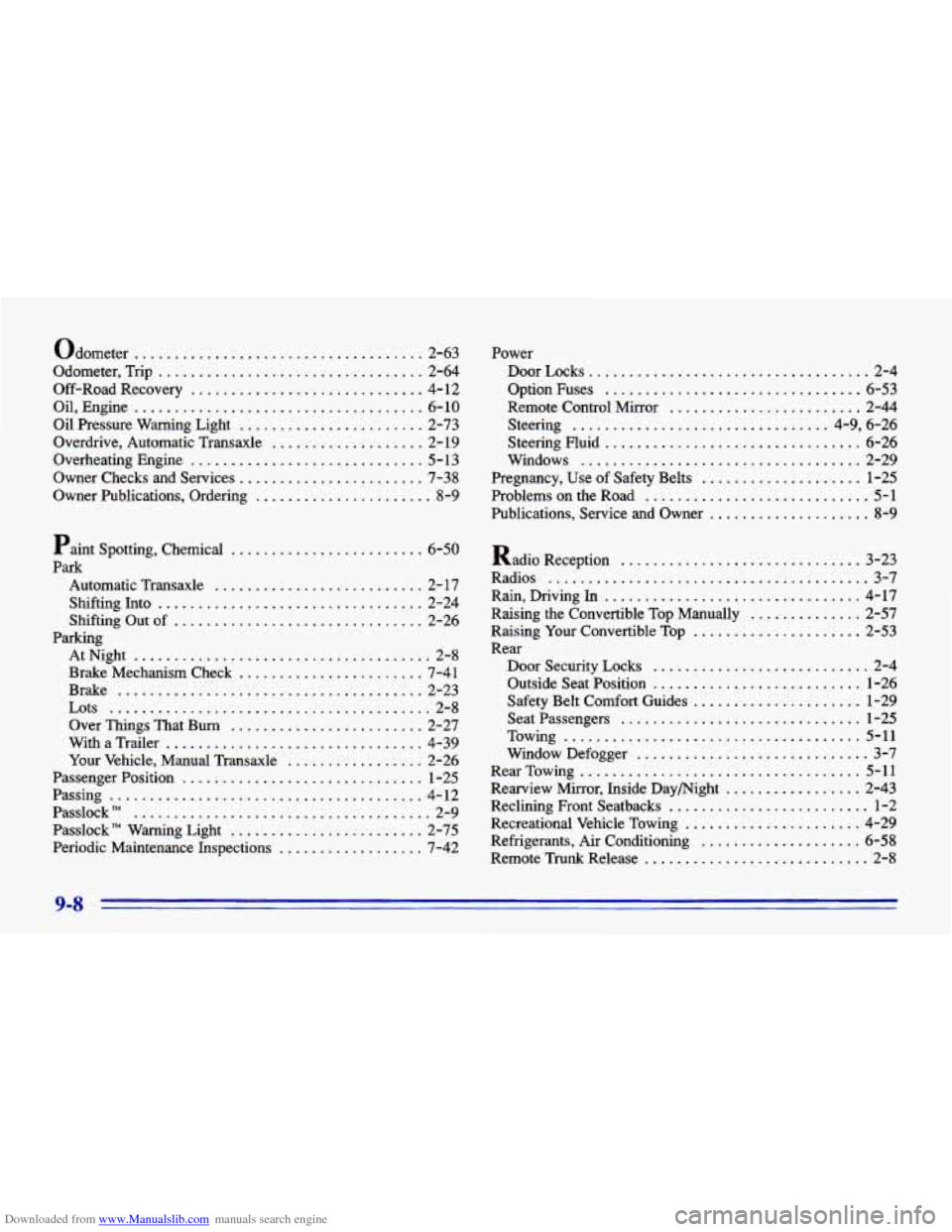
Downloaded from www.Manualslib.com manuals search engine Odometer .................................... 2-63
Odometer. Trip
................................. 2-64
Off-Road Recovery
............................. 4- 12
Oil. Engine
.................................... 6-10
Oil Pressure Warning Light
....................... 2-73
Overdrive. Automatic Transaxle
................... 2- 19
Overheating Engine
............................. 5- 13
Owner Checks and Services
....................... 7-38
Owner Publications. Ordering
...................... 8-9
Paint Spotting. Chemical
........................ 6-50
Park Automatic Transaxle
.......................... 2- 17
Shifting
Into ................................. 2-24
Shifting Out
of ............................... 2-26
At Night
..................................... 2-8
Parking
Brake Mechanism Check
....................... 7-41
Brake
...................................... 2-23
Lots
........................................ 2-8
Over Things That Bum
........................ 2-27
WithaTrailer
................................ 4-39
Your Vehicle. Manual Transaxle
................. 2-26
Passenger Position
.............................. 1-25
Passing
....................................... 4-12
Passlock
TM ..................................... 2-9
Passlock
TM Warning Light ........................ 2-75
Periodic Maintenance Inspections
.................. 7-42 Power
Door Locks
................................... 2-4
Remote Control Mirror
........................ 2-44
Option Fuses
................................ 6-53
Steering
................................ 4.9. 6.26
Steering Fluid
................................ 6-26
Windows
................................... 2-29
Pregnancy. Use of Safety Belts
.................... 1-25
Problems on the Road
............................ 5-1
Publications. Service and Owner .................... 8-9
Radio Reception
.............................. 3-23
Radios
........................................ 3-7
Rain. Driving In
................................ 4-17
Raising the Convertible Top Manually
.............. 2-57
Raising Your Convertible Top
..................... 2-53
Rear DoorSecurityLocks
........................... 2-4
Outside Seat Position .......................... 1-26
Safety Belt Comfort Guides
..................... 1-29
Seatpassengers
.............................. 1-25
Towing
..................................... 5-11
Window Defogger
............................. 3-7
Reclining Front Seatbacks
......................... 1-2
Recreational Vehicle Towing
...................... 4-29
Refrigerants. Air Conditioning
.................... 6-58
Remote Trunk Release
............................ 2-8
RearTowing ................................... 5-11
Rearview Mirror. Inside Daymight
................. 2-43
9-8